vue2與vue3中的生命週期執行順序有何不同
- PHPz轉載
- 2023-05-16 21:40:332661瀏覽
vue2與vue3中生命週期執行順序區別
生命週期比較
vue2中執行順序
beforeCreate=>created=>beforeMount=>mounted=>beforeUpdate=>updated=>beforeDestroy=>destroyed-
#vue3中執行順序
setup=>onBeforeMount=>onMounted=>onBeforeUpdate=>onUpdated=>onBeforeUnmount=>onUnmounted
對應關係
vue2->vue3
beforeCreate->setup#created->setupbeforeMount->onBeforeMountmounted->onMountedbeforeUpdate->onBeforeUpdate##updated
-> ;onUpdatedbeforeDestroy
->onBeforeUnmount#destroyed
->onUnmounted
<template> <h2>App父级组件</h2> <button @click="childShow = !childShow">切换child子组件的显示</button> <hr /> <child v-if="childShow" /> </template>
<script lang="ts">
import { defineComponent, reactive, ref } from "vue";
//引入子组件
import child from "./components/child.vue";
export default defineComponent({
name: "App",
components: {
child,
},
setup() {
const childShow = ref(true);
return {
childShow,
};
},
});
</script><style>
* {
margin: 0;
padding: 0;
}
</style>子元件child.vue<template>
<h3>child 子级组件</h3>
<h4>{{ name }}</h4>
<button @click="updateName">更新name</button>
</template>
<script lang="ts">
import {
defineComponent,
onBeforeMount,
onMounted,
onBeforeUpdate,
onUpdated,
onBeforeUnmount,
onUnmounted,
ref,
} from "vue";
export default defineComponent({
name: "child",
//vue2中的生命周期钩子
beforeCreate() {
console.log("vue2 中的生命周期 beforeCreate");
},
created() {
console.log("vue2 中的生命周期 created");
},
beforeMount() {
console.log("vue2 中的生命周期 beforeMount");
},
mounted() {
console.log("vue2 中的生命周期 mounted");
},
beforeUpdate() {
console.log("vue2 中的生命周期 beforeUpdate");
},
updated() {
console.log("vue2 中的生命周期 updated");
},
// vue2中的 beforeDestroy与 destroyed已经改名 无法使用
beforeUnmount() {
console.log("vue2 中的生命周期 beforeDestroy(beforeUnmount)");
},
unmounted() {
console.log("vue2 中的生命周期 destroyed(unmounted)");
},
setup() {
console.log("vue3中的setup");
const name = ref("hhh");
const updateName = () => {
name.value += "6……6………6";
};
onBeforeMount(() => {
console.log("vue3 中的生命周期 onBeforeMount");
});
onMounted(() => {
console.log("vue3 中的生命周期 onMounted");
});
onBeforeUpdate(() => {
console.log("vue3 中的生命周期 onBeforeUpdate");
});
onUpdated(() => {
console.log("vue3 中的生命周期 onUpdated");
});
onBeforeUnmount(() => {
console.log("vue3 中的生命周期 onBeforeUnmount");
});
onUnmounted(() => {
console.log("vue3 中的生命周期 onUnmounted");
});
return {
name,
updateName,
};
},
});
</script>運作起來的顯示效果
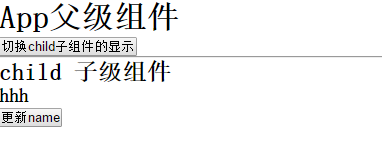 ##進入頁面按f12 開啟偵錯刷新頁面
##進入頁面按f12 開啟偵錯刷新頁面
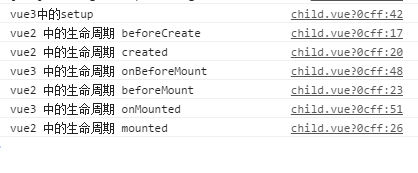
- setup
執行在beforeCreate與created前面;
- onBeforeMount
執行在beforeMount前面;
##onMounted - 執行在mounted前面;
點選更新name
 #可以看出vue3中
#可以看出vue3中
- onBeforeUpdate
- 執行在beforeUpdate前面;
- 執行在updated前面;
#點選切換child子元件的顯示
 #可以看出vue3中
#可以看出vue3中
- onBeforeUnmount
- 執行在beforeDestroy前面;
- 執行在destroyed前面;
- 三種情況下的生命週期執行順序
- 生命週期:在創建一個vue實例時,會經歷一系列的初始化過程(Vue實例從創建到銷毀的過程),這個過程就是vue的生命週期。 Vue提供給開發者的一系列的回呼函數,方便我們添加自訂的邏輯,Vue的生命週期從創建到銷毀,重要的節點掛載資料更新。
- 建立階段beforeCreate、created
#更新階段beforeUpdate、updated
- 卸載階段beforeDestory、destoryed
- 1、單頁下生命週期順序獻上一波程式碼,看下各週期鉤子函數的執行順序:
<!DOCTYPE html>
<html lang="en">
<head>
<meta charset="UTF-8">
<meta name="viewport" content="width=device-width, initial-scale=1.0">
<meta http-equiv="X-UA-Compatible" content="ie=edge">
<title>vue生命周期学习</title>
<script src="https://cdn.bootcss.com/vue/2.4.2/vue.js"></script>
</head>
<body>
<div id="app">
<h2>{{message}}</h2>
</div>
</body>
<script>
var vm = new Vue({
el: '#app',
data: {
message: 'Vue的生命周期'
},
beforeCreate: function() {
console.group('------beforeCreate创建前状态------');
console.log("%c%s", "color:red" , "el : " + this.$el); //undefined
console.log("%c%s", "color:red","data : " + this.$data); //undefined
console.log("%c%s", "color:red","message: " + this.message)
},
created: function() {
console.group('------created创建完毕状态------');
console.log("%c%s", "color:red","el : " + this.$el); //undefined
console.log("%c%s", "color:red","data : " + this.$data); //已被初始化
console.log("%c%s", "color:red","message: " + this.message); //已被初始化
},
beforeMount: function() {
console.group('------beforeMount挂载前状态------');
console.log("%c%s", "color:red","el : " + (this.$el)); //已被初始化
console.log(this.$el);
console.log("%c%s", "color:red","data : " + this.$data); //已被初始化
console.log("%c%s", "color:red","message: " + this.message); //已被初始化
},
mounted: function() {
console.group('------mounted 挂载结束状态------');
console.log("%c%s", "color:red","el : " + this.$el); //已被初始化
console.log(this.$el);
console.log("%c%s", "color:red","data : " + this.$data); //已被初始化
console.log("%c%s", "color:red","message: " + this.message); //已被初始化
},
beforeUpdate: function () {
console.group('beforeUpdate 更新前状态===============》');
console.log("%c%s", "color:red","el : " + this.$el.innerHTML);
console.log(this.$el);
console.log("%c%s", "color:red","data : " + this.$data);
console.log("%c%s", "color:red","message: " + this.message);
},
updated: function () {
console.group('updated 更新完成状态===============》');
console.log("%c%s", "color:red","el : " + this.$el.innerHTML);
console.log(this.$el);
console.log("%c%s", "color:red","data : " + this.$data);
console.log("%c%s", "color:red","message: " + this.message);
},
beforeDestroy: function () {
console.group('beforeDestroy 销毁前状态===============》');
console.log("%c%s", "color:red","el : " + this.$el);
console.log(this.$el);
console.log("%c%s", "color:red","data : " + this.$data);
console.log("%c%s", "color:red","message: " + this.message);
},
destroyed: function () {
console.group('destroyed 销毁完成状态===============》');
console.log("%c%s", "color:red","el : " + this.$el);
console.log(this.$el);
console.log("%c%s", "color:red","data : " + this.$data);
console.log("%c%s", "color:red","message: " + this.message)
}
})
</script>
</html>(1)建立階段:初始化事件,進行資料的觀測
########### new Vue({}) 建立一個空的實例對象,這個物件上只有生命週期函數和一些預設事件############在beforeCreate時,$el和data都未初始化#### #########created 執行,完成了對data的初始化,透過編譯將template 模板轉換成渲染函數( render ) ,執行渲染函數就可以得到一個虛擬節點樹(記憶體中)###如果有模板文件,则编译成渲染函数;如果没有,则使用外部 HTML 作为模板进行渲染。综合排名优先级:render函数选项 > template选项 > outer HTML.
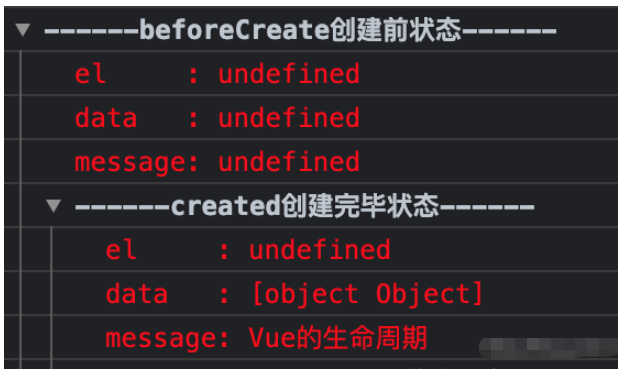
(2)挂载阶段
为vue实例添加$el成员,替换挂载的DOM成员
其中在beforeMount时,初始化el和data,但el和data,但el和data,但el还是使用{{message}}进行占位
mounted执行时,将message的值进行渲染
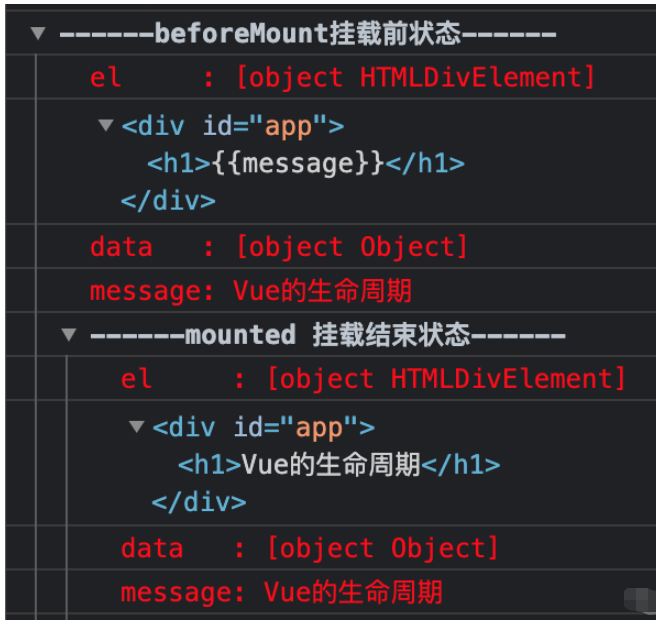
(3)更新阶段:触发对应组件的重新渲染
data 被改变时触发生命周期函数 beforeUpdate 执行,data是最新的,页面还未更新(旧的页面)
根据最新的 data 重新渲染虚拟 DOM,并挂载到页面上,完成 Model 到 View 的更新
updated 执行,此时 data 和页面都是最新的

(4)销毁阶段
beforeDestroy钩子函数在实例销毁之前调用。在这一步,实例仍然完全可用。
destroyed钩子函数在Vue 实例销毁后调用。一旦调用,Vue 实例所绑定的所有内容都将被解绑,包括事件监听器,同时所有子实例都将被销毁。
2、父子、兄弟组件的生命周期顺序
<template> <div class="father"> <component-A class="son_A"></component-A> <component-B class="son_B"></component-B> </div> </template> // script部分同上代码,不多写了。
主要可以从以下几种情况分析:
(1)创建过程:
父beforeCreate->父created->父beforeMount->子beforeCreate->子created->子beforeMount->子mounted->父mounted

(2)组件的内部更新:
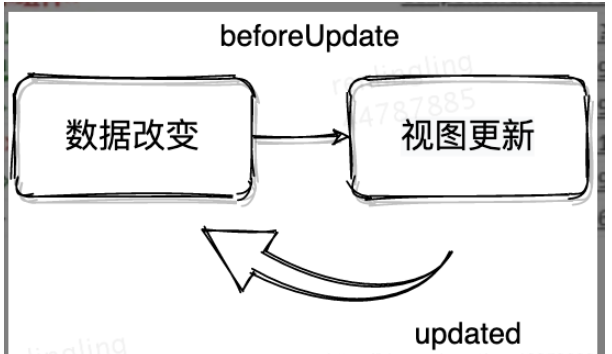
子组件的内部更新过程是:子beforeUpdate->子updated
同理父组件的内部更新过程也是:父beforeUpdate->父updated
(3)组件之间的更新:
当子组件使用emit修改父组件状态时,刚好这个状态又绑定在子组件的props上,更新过程是:父beforeUpdate->子beforeUpdate->子updated->父updated
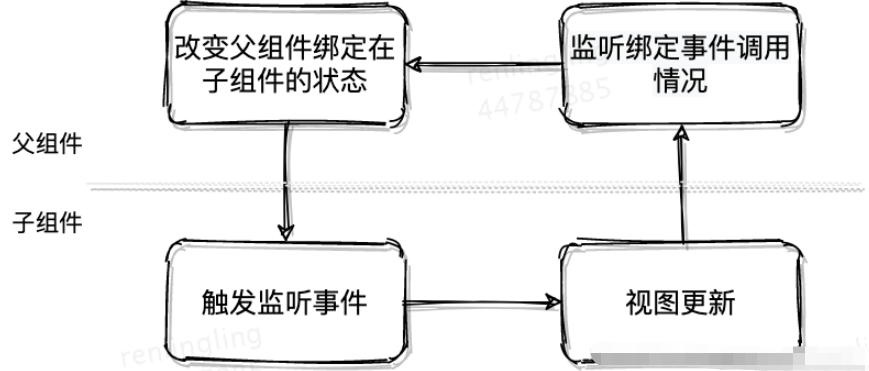
(4)父子组件销毁:
父组件被销毁时子组件也同时被销毁,销毁的钩子过程是:父beforeDestroy->子beforeDestroy->子destroyed->父destroyed

父子组件完整的生命周期图如下所示:
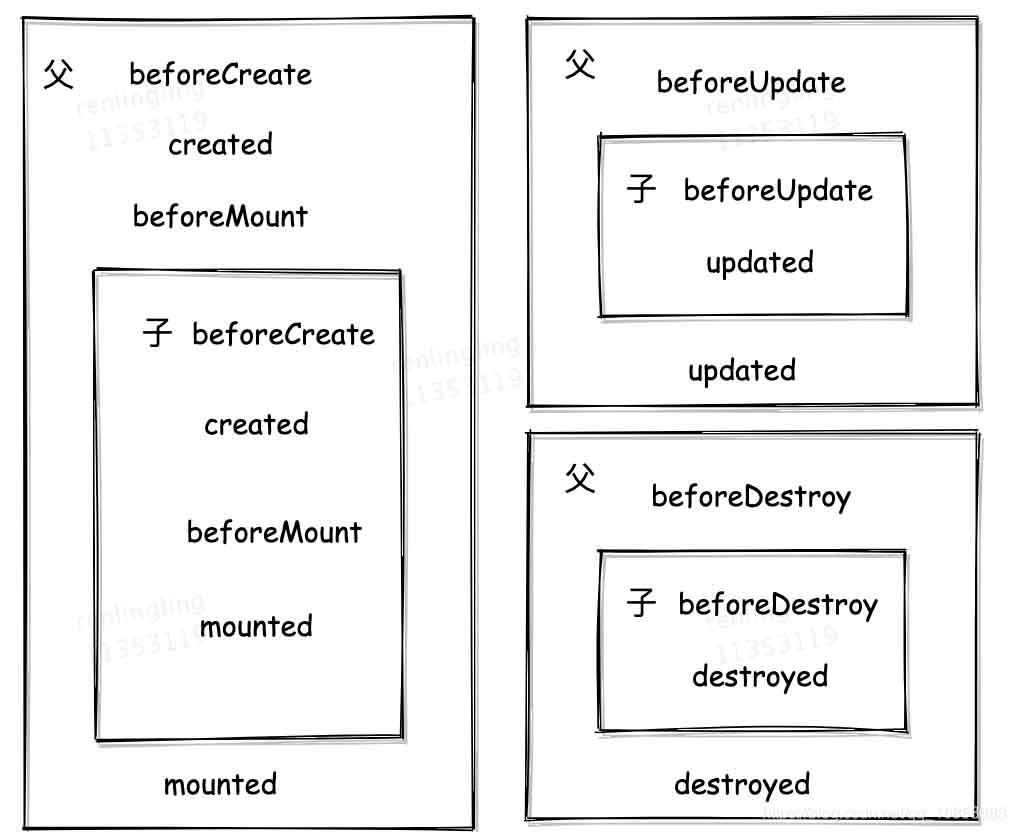
从上图可以看出,在父兄子组件挂载前,各组件的实例已经初始化完成。
子组件挂载完成后,父组件还未挂载。因此,在父组件的mounted钩子中获取API数据时,子组件的mounted钩子无法获取到该数据。
仔细看看父子组件生命周期钩子的执行顺序,会发现created这个钩子是按照从外内顺序执行,所以回显场景的解决方案是:在created中发起请求获取数据,依次在子组件的created中会接收到这个数据。
无论嵌套多少层,Vue父子组件的生命周期钩子执行顺序都是从外到内再从内到外。
3、不同页面跳转时各页面生命周期的执行顺序
跳转不同页面和part2是相同的原理,从第一个页面(index)跳转到下一个页面(secondIndex)时,回先初始化secondIndex,之后在执行index页面的销毁阶段,最后secondIndex挂载完成.
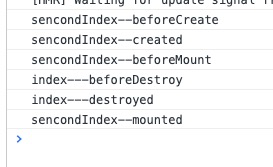
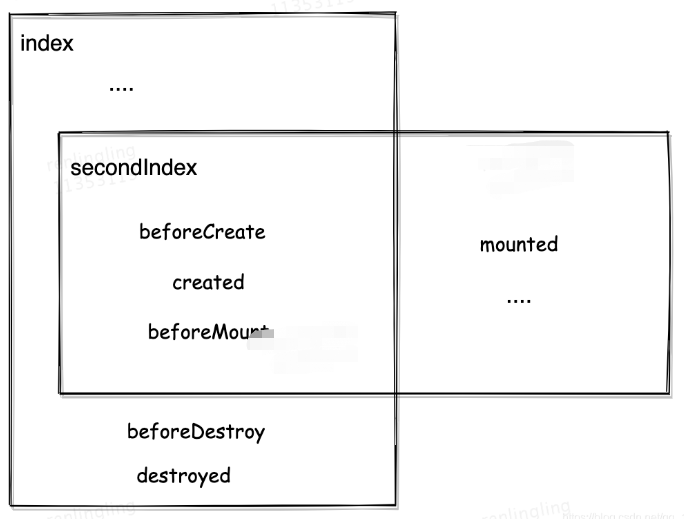
以上是vue2與vue3中的生命週期執行順序有何不同的詳細內容。更多資訊請關注PHP中文網其他相關文章!

